-
What is an L.E.D?
-
What is the advantages of L.E.D?
-
How does LED work?
-
What is RGB, RGBW, RGBA and RGBCCT?
-
What certificate do we have?
In the simplest terms, a light-emitting diode (LED) is a semiconductor device that emits light when an electric current is passed through it. Light is produced when the particles that carry the current (known as electrons and holes) combine together within the semiconductor material. Since light is generated within the solid semiconductor material, LEDs are described as solid-state devices. The term solid-state lighting, which also encompasses organic LEDs (OLEDs), distinguishes this lighting technology from other sources that use heated filaments (incandescent and tungsten halogen lamps) or gas discharge (fluorescent lamps).
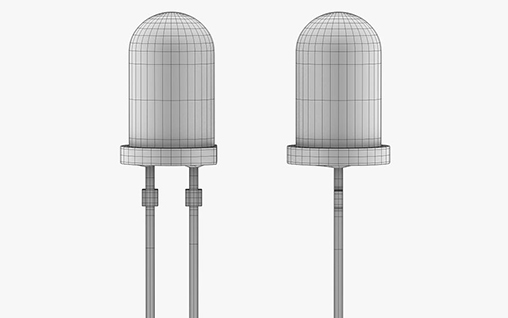

LED (Light Emitting Diodes) lights are the latest and most fascinating technological advancement in the lighting industry. LEDs are small, solid light bulbs that are powerful, energy-efficient, and long lasting. LEDs operate in different ways than traditional incandescent bulbs. This makes LEDs far more durable than traditional incandescent light bulbs. LED technology also provides many additional advantages over incandescent, fluorescents, and compact fluorescent lamps and lighting devices. This includes an exceptionally longer lifespan (60,000 hours), significantly lower energy consumption (90% more efficient), reduced maintenance costs, and higher safety.
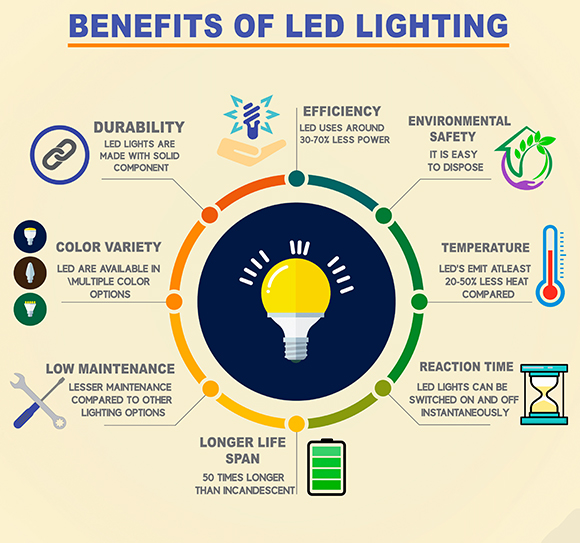
You certainly hear and read a lot about the benefits associated with the energy efficiency of LED light emitting diodes versus traditional lighting. When you compare them to other energy-saving illumination methods that are currently available, you will find that LED lamps are definitely the smartest and most power-saving solution for illumination. The top 8 benefits of using LED lights over their less efficient alternatives can be read below.
Efficiency
LEDs are packed powerfully with sufficient energy and use up to 90% less power than incandescent light bulbs.
Longevity
LEDs have a lifespan of up to 60,000 hours as opposed to 1,500 hours typical of incandescent bulbs.
Sturdiness
LEDs are solid express lighting devices that utilize semiconductor material rather than a filament or neon gas.
Safety
Superior safety may be the most significant benefit of LEDs. LED lamps generate almost no warmth therefore they are cool to the touch and can be left on for hours without incident or consequence if touched, no glass, no UV and IR, no mercury and so on.
Environment
LEDs are made of non-toxic materials, unlike neon lighting that use mercury that may pose a danger to the environment. LED is recyclable and also considered “green”, or earth-friendly.
Color
LED lighting are offered in a variety of base colors, such as red, blue, and amber. Due to the fact that traditional incandescent bulbs use filters to produce colors, they are extremely bad. LEDs can be mixed together to produce large numbers of color options.
Long-term
LEDs are poised to replace traditional incandescent lights. LEDs are rapidly, without a doubt, becoming the preferred lighting solution of both homes and offices. long-lasting life up to 50,00 hours.
Uses
LEDs are currently used for a wide variety of different applications, such as in residential lighting, the military, as well as the architectural, automotive, transmissions, electronic instrumentation, the entertainment and gaming, the military, and the traffic and transportation industry. Since LEDs are focused lights, they are great at performing some specific lighting tasks, such as desk lamps, reading lights, night lights, security signals, spotlights, accent lamps, and lighting for signs.
LEDs create light
by electroluminescence in a semiconductor material.
Electroluminescence is the phenomenon of a material emitting light when
electric current or an electric field is passed through it - this happens when
electrons are sent through the material and fill electron holes. An electron
hole exists where an atom lacks electrons (negatively charged) and
therefore has a positive charge. Semiconductor materials like germanium or
silicon can be "doped" to create and control the number of electron
holes. Doping is the adding of other elements to the
semiconductor material to change its properties. By doping a semiconductor you
can make two separate types of semiconductors in the same crystal. The boundary
between the two types is called a p-n junction. The junction only allows
current to pass through it one way, this is why they are used as diodes. LEDs
are made using p-n junctions. As electrons pass through one crystal to the
other they fill electron holes. They emit photons (light).

The P-N junction
is the basis of the functioning of the LED. The LED has an anode and a cathode
separated by a crystal of semiconductor material. Addition of impurities to the
semiconductor material produces P-N junctions within the chip. The entire
assembly is within a plastic cover that can also double up as a lens to guide
the light emitted by the LED.
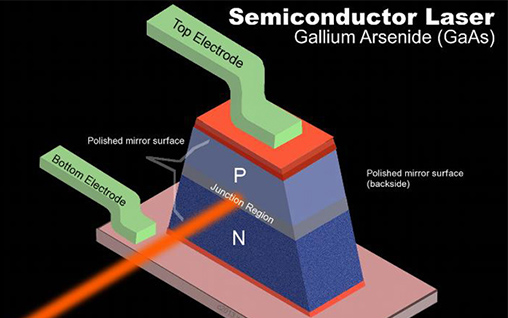
Phosphors are used to help filter the light output of the LED. They create a more pure "harsh" color. Engineers had to figure out how to control the angle the light escapes the semiconductor, this "light cone" is very narrow. They figured out how to make light refract or bounce off all surfaces of the semiconductor crystal to intensify the light output. This is why LED displays traditionally have been best viewed from one angle.
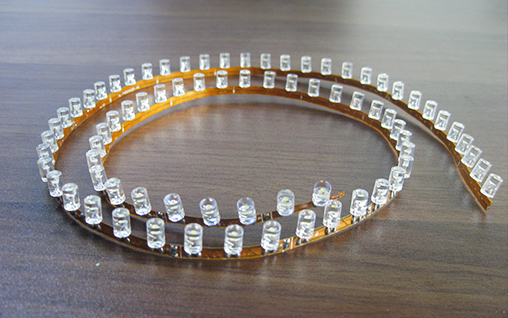
RGB:
Standard RGB LED strip uses a 3-in-1 LED chip made up of red, green and blue chips. It can produce a wide range of colours by mixing the three and looks almost white with all three at full brightness. RGB+W LED strip uses either a 4-in-1 LED chip that has a white chip as well as red, green and blue or an RGB chip alongside a white chip.
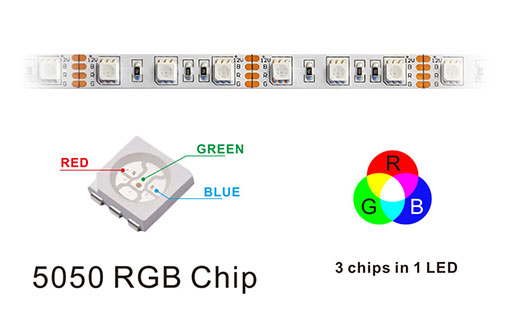
RGBW:
Fixtures with red, green, blue and white LEDs create vivid (warm white or cold white), bright colors. RGBW fixtures project a cool shade of white and are ideal for color mixing pastels. Add white to any standard color and adjust the saturation to achieve your client’s desired shade. In addition to creating pastels, white LEDs can be used independently so you do not have to mix colors to achieve it. Choosing the right LED combination depends on your gigs and the colors you want to achieve. Before you make your purchase, do some homework and check your books to see what colors received the most requests, ask your fellow DJ friends about their client’s requests or log onto a DJ forum and conduct your own poll. Both combinations create an enormous amount of colors — deciding on the shade of those colors is where your expertise comes in.
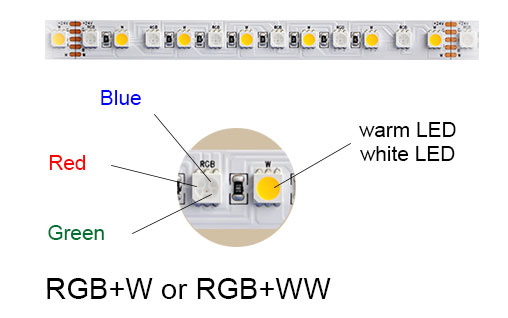
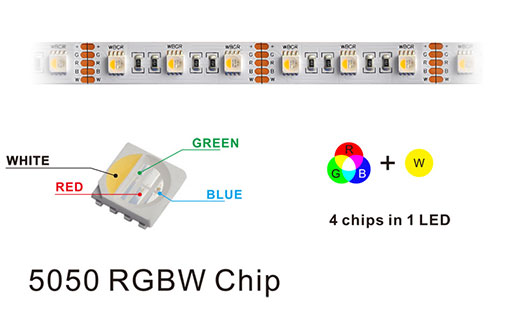
RGBA:
Fixtures with red, green, blue and amber LEDs create warm, rich colors. RGBA fixtures project a warm shade of white and exceptionally rich shades of gold, yellow and orange. Additionally, adding amber to standard colors broadens the color spectrum. Amber LEDs are a major benefit to RGBA fixtures because it is difficult to achieve the amber color through color mixing.

RGBCCT:
We can call also RGBWW, ingetrating RGB and warm white LED and White LED to one 5-in-1 LED creates better-quality color temperature adjustment 27600-6500K compared to RGBW, The RGBCCT led strip light is an upgraded version of the RGBW led strip. It does not have a fixed color temperature like white color light in RGBW led strip, but has two color temperature led chips, a warm white in 2600K, and a white color light in 6500K,which makes the color temperature selection in the lighting application scene more flexible. It also have RGB color changing tegher to reaches amazing lighting effect to designer.

We have the CE RoHs cerficate for European clients and also UL/CUL for the American & Canada clients. UL listing number : E487406

